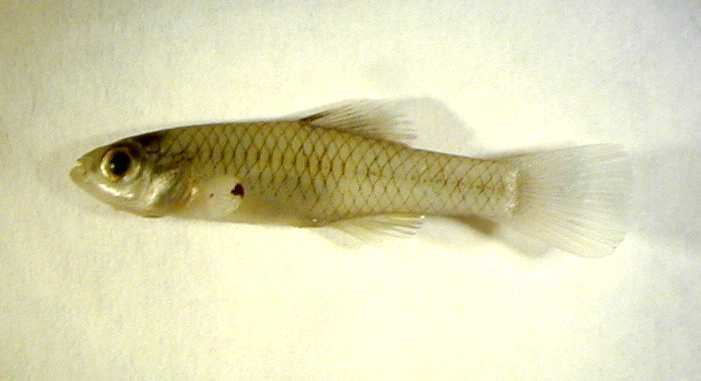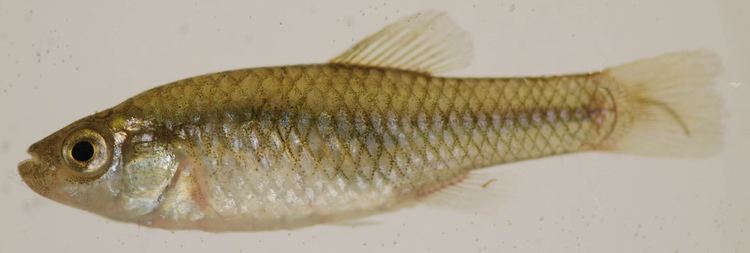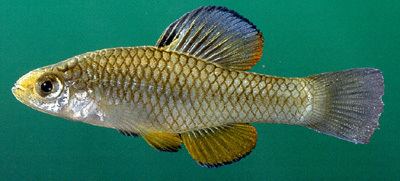Genus Lucania Phylum Chordata Rank Species | Scientific name Lucania parva Higher classification Lucania | |
 | ||
Similar Lucania, Fundulidae, Lucania goodei, Stippled studfish, Sheepshead minnow | ||
Description
Maximum size: 62 mm SL (Gunter 1950).
Contents

Coloration: Body not barred (Hubbs et al. 1991). Back silvery to light green, with a narrow, dark middorsal stripe. Scales on sides outlined in melanophores, creating cross-hatched pattern, which is especially prominent in breeding males. Forward and upper surfaces of the head speckled with melanophores, which also extend onto the underside of the lower jaw. Belly and undersides of body are silver. Fins generally lack pigmentation, except for some melanophores along the rays. In breeding males, dorsal fin has a black anterior blotch and dark marginal and basal bands that may include orange pigmentation. Caudal, anal, and pelvic fins red to orange, with black marginal bands (Gunter 1950; Simpson and Gunter 1956; Ross 2001).

Counts: 10+ dorsal fin rays; 8-13 scale rows from pelvic origin to isthmus; 30 or fewer longitudinal scale rows (Hubbs et al. 1991); 27 (26-28) lateral scales; 11 (9-13) dorsal fin rays; 13 (12-14) pectoral fin rays; 6 (4-7) pelvic fin rays; 9 (8-13) anal fin rays; 16 (15- 18) caudal fin rays; 8 (5-9) gill rakers on 1st arch (Sublette et al. 1990).

Body shape: Body deep, rather compressed; head flattened above, tapering to vertically rounded, blunt snout (Hardy 1978). Body depth contained four times in standard length (Hubbs et al. 1991). Body axis straight (Sublette et al. 1990).
Mouth position: Supraterminal, oblique; mouth small; obliquely sloped, protruding lower jaw (Sublette et al. 1990).

External morphology: Distance from origin of dorsal fin to end of hypural plate more than distance from origin of dorsal fin to preopercle (Hubbs et al. 1991); dorsal and caudal fins rounded; pectorals, pelvic, anal fins rounded at apex (Sublette et al. 1990). Males develop prickly contact organs on top and sides of head and on side of body between dorsal and anal fin bases (Foster 1967; Collette 1977). Female with membranous sheath surrounding genital opening (Sublette et al. 1990).
Internal morphology: Teeth conical and simple (Hubbs et al. 1991). Premaxillary and mandibular teeth uniserial or irregular, occasionally with a few strong inner teeth (Sublette et al. 1990).
Diet

Simpson and Gunter (1956) and Harrington and Harrington (1961) reported diet items including larval crustaceans (mainly cyclopoid and harpacticoid copepods), mosquito larvae, small worms, and mollusks. Harrington and Harrington (1961) noted that the species heavily predates both larvae and pupae of saltmarsh mosquitoes.
Habitat
Found in salt marshes, bays, and lagoons from Cape Cod, Massachusetts to Tampico, Mexico (Duggins 1980a); common in freshwaters of St. John’s River system, Florida (Burgess 1977), and Rio Grande and Pecos River in Texas and New Mexico (Duggins 1980a). Lucania parva is a schooling species (Hardy 1978).
Reproduction and Life Cycle
Spawning season: In Texas, females began ripening in February, and a few were gravid in July; peak spawning in May and June (males displayed breeding coloration from February into June, or July, with greatest color intensity in May; Gunter 1950); may occur in earlier in the spring (Simpson and Gunter 1956). Sublette et al. (1990) reports spawning in New Mexico from spring – fall, at least in southern portion of state.
Spawning location: During spawning, male and female swim into vegetation with fine leaves; there eggs are released and fertilized; eggs have mucous threads with which they are attached to plant material (Foster 1967). McLane (1955) noted that male courtship behavior was observed near clumps of Naias and Vallisneria.
Reproductive strategy: A courting male swims in loops slightly below the female, waiting for the female to respond by stopping; after a female stops, the male moves under her flicking his head against her throat; pair moves slowly toward surface of the water, while male continues to rub his head against underside of the female; when they are near surface, female swims into vegetation having fine leaves or algal masses, and the male follows; using his dorsal and anal fins, the male then clasps female, and eggs are released and fertilized (Foster 1967).
Fecundity: 7-46 ripe ova (mean 24.5 per fish) plus numerous smaller ova (McLane 1955); maximum reported count 104 (Hildebrand and Schroeder 1928; Hardy 1978). Freshly laid eggs are spherical, nearly colorless, having chorionic threads; live eggs averaging 1.23 mm in diameter; eggs hatch in 6 days at water temperature of 23.9 degrees C (Foster 1967). More than one brood may be produced per year by a single female (Hardy 1978).
Distribution
Native to coastal waters from Massachusetts to Tampico, Mexico (Hubbs et al. 1991). Introduced into California, Nevada, Oregon, and Utah (Hubbs and Miller 1965). Locally abundant in lower Pecos River drainage, New Mexico, not ascending tributary streams far above mouth (Cowley and Sublette 1987).
Etymology
Lucania: a coined name without meaning; parva: small (Ross 2001).
